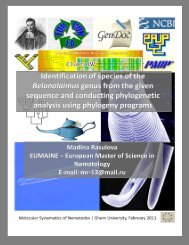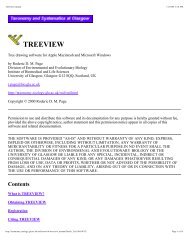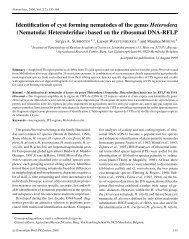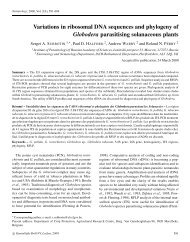Description of Tylenchulus musicola sp. n. (Nematoda ...
Description of Tylenchulus musicola sp. n. (Nematoda ...
Description of Tylenchulus musicola sp. n. (Nematoda ...
You also want an ePaper? Increase the reach of your titles
YUMPU automatically turns print PDFs into web optimized ePapers that Google loves.
Z. Tanha Maafi et al.<br />
Fig. 6. The 50% majority rule consensus tree from Bayesian analysis generated from the D2-D3 <strong>of</strong> 28S rRNA gene sequence dataset<br />
for <strong>Tylenchulus</strong> <strong>sp</strong>ecies using the GTR + I + G model. Posterior probability more than 70% is given for appropriate clades. Newly<br />
obtained sequences indicated in bold.<br />
The genus-<strong>sp</strong>ecific and universal D2A primers yielded an<br />
amplicon <strong>of</strong> ca 360 bp in length for all tested <strong>Tylenchulus</strong><br />
samples. No PCR products were detected in the samples<br />
<strong>of</strong> Trophotylenchulus floridensis and other parasitic nematodes<br />
(data not shown).<br />
Species-<strong>sp</strong>ecific primers were developed for each <strong>Tylenchulus</strong><br />
<strong>sp</strong>ecies based on differences in the ITS-rRNA<br />
gene sequences (Table 2; Fig. 9). Results <strong>of</strong> PCR with<br />
<strong>sp</strong>ecies-<strong>sp</strong>ecific primers are given in Figure 10. The combination<br />
<strong>of</strong> universal primer TW81 with corre<strong>sp</strong>onding<br />
<strong>sp</strong>ecies-<strong>sp</strong>ecific primers yielded a single PCR product in<br />
113 bp for T. semipenetrans, 190 bp for T. <strong>musicola</strong> <strong>sp</strong>.<br />
n., 344 bp for T. palustris, 690 bp for T. furcus and 767<br />
bp for T. graminis. All these primer combinations were<br />
successfully tested in a multiplex PCR.<br />
Comparative sensitive testing <strong>of</strong> our <strong>sp</strong>ecific primer<br />
for T. semipenetrans and the primer set designed by Liu<br />
et al. (2011) showed that both PCR methods are able<br />
successfully to detect a single J2 in a sample (Fig. 11).<br />
Analysis <strong>of</strong> the sequence alignment (Fig. 9) revealed<br />
that primer Ts-SF by Liu et al. (2011) targets only<br />
T. semipenetrans and thus, in silico analysis including all<br />
known <strong>Tylenchulus</strong> <strong>sp</strong>ecies confirms the <strong>sp</strong>ecificity <strong>of</strong> the<br />
method <strong>of</strong> detection for T. semipenetrans developed by<br />
Liu et al. (2011).<br />
364 Nematology
















